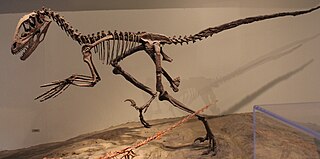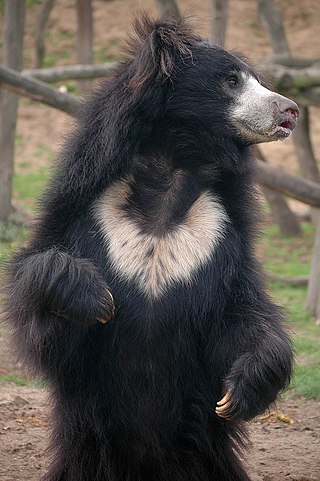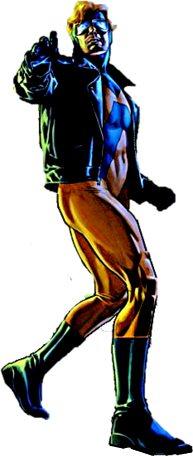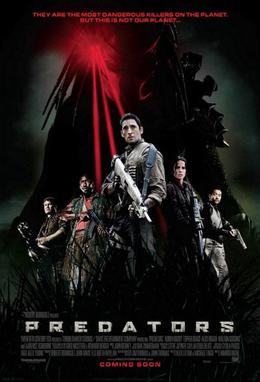Related Research Articles

Deinonychus is a genus of dromaeosaurid theropod dinosaur with one described species, Deinonychus antirrhopus. This species, which could grow up to 3.4 meters (11 ft) long, lived during the early Cretaceous Period, about 115–108 million years ago. Fossils have been recovered from the U.S. states of Montana, Utah, Wyoming, and Oklahoma, in rocks of the Cloverly Formation and Antlers Formation, though teeth that may belong to Deinonychus have been found much farther east in Maryland.
Arthur Porges was an American writer of numerous short stories, most notably during the 1950s and 1960s, though he continued to write and publish stories until his death.

The sloth bear, also known as the Indian bear, is a myrmecophagous bear species native to the Indian subcontinent. It feeds on fruits, ants and termites. It is listed as vulnerable on the IUCN Red List, mainly because of habitat loss and degradation. It is the only species in the genus Melursus.

Animal Man is a superhero appearing in American comic books published by DC Comics. As a result of being in proximity to an exploding extraterrestrial spaceship, Buddy Baker acquires the ability to temporarily "borrow" the abilities of animals. Using these powers, Baker fights crime as the costumed superhero Animal Man.

A Princess of Mars is a science fantasy novel by American writer Edgar Rice Burroughs, the first of his Barsoom series. It was first serialized in the pulp magazine All-Story Magazine from February–July, 1912. Full of swordplay and daring feats, the novel is considered a classic example of 20th-century pulp fiction. It is also a seminal instance of the planetary romance, a subgenre of science fantasy that became highly popular in the decades following its publication. Its early chapters also contain elements of the Western. The story is set on Mars, imagined as a dying planet with a harsh desert environment. This vision of Mars was based on the work of the astronomer Percival Lowell, whose ideas were widely popularized in the late 19th and early 20th centuries.

After Worlds Collide (1934) is a sequel to the 1933 science fiction novel, When Worlds Collide. Both novels were co-written by Edwin Balmer and Philip Wylie. After Worlds Collide first appeared as a six-part monthly serial in Blue Book magazine. Much shorter and less florid than the original novel, this one tells the story of the survivors' progress on their new world, Bronson Beta, after the destruction of the Earth.
"Tooth and Claw" is the second episode of the second series of the British science fiction television series Doctor Who, which was first broadcast on BBC One on 22 April 2006.

The Chessmen of Mars is a science fantasy novel by American writer Edgar Rice Burroughs, the fifth of his Barsoom series. Burroughs began writing it in January, 1921, and the finished story was first published in Argosy All-Story Weekly as a six-part serial in the issues for February 18 and 25 and March 4, 11, 18 and 25, 1922. It was later published as a complete novel by A. C. McClurg in November 1922.
"Mars University" is the eleventh episode in the first season of the American animated television series Futurama. It originally aired on the Fox network in the United States on October 3, 1999. This episode was written by J. Stewart Burns and directed by Bret Haaland.
Prince Thun is a fictional character who appeared in various forms of the Flash Gordon comic strip and film productions. He is a Lion Man of Mongo and one of Flash's most trusted friends. His Father is King Jugrid, ruler of the Lion Men, and one of the three mightiest rulers of Mongo.

Stephen Robert Irwin, known as "The Crocodile Hunter", was an Australian zookeeper, conservationist, television personality, wildlife educator, and environmentalist.

Batman/Aliens is a crossover between the Batman and Aliens comic book franchises. It was published in 1997. A sequel was released in 2003.

Katy, la oruga is a special single by Lucerito, this single was a gift for the purchase of the Discopóster Magazine. First edition was released on 1984. The songs from this single were included in the soundtrack of the Spanish-Mexican animated film of 1984 produced by Fabian Arnaud and directed by José Luis Moro and Santiago Moro and is based from an original story by Silvia Roche.

Predators is a 2010 American science fiction action film directed by Nimród Antal, serving as the third film in the main series of the Predator franchise and its fifth film overall. The film follows an ensemble cast starring Adrien Brody, Topher Grace, Alice Braga, Walton Goggins, and Laurence Fishburne, and follows a group of proficient killers who have been abducted and placed on a planet that acts as a game preserve for two warring tribes of extraterrestrial predators, leading them to try and survive and look for a way back to Earth.
Dark Days in Monkey City is an Animal Planet documentary series about the lives of wild toque macaques in Sri Lanka. In the tradition of Meerkat Manor it followed the stories of individual primates, but differed from earlier shows by adding special effects and transitional animation.
"Byomjatrir Diary" is the first story of the Professor Shonku series created by Indian writer and filmmaker Satyajit Ray. It was first published in Sandesh, edited by Ray himself, in 1961. Ray included this story in his first collection of Shonku stories, Professor Shonku, in 1965. The story follows Professor Trilokeshwar Shonku, a Bengali scientist and inventor, who travelled to Mars and after being attacked by the Martians, fled to a planet named Tafa, where the inhabitants welcomed him and made him a citizen of their planet.
Jumpin' Jupiter is a 1955 Warner Bros. Merrie Melodies cartoon directed by Chuck Jones. The short was released on August 6, 1955 and stars Porky Pig and Sylvester.

The lava bear is a variety of American black bear found in the lava beds of south central Oregon. The animal was described as a very small bear with wooly light brown fur. The few lava bears that were killed or captured were a little larger than a badger. It was once thought to be a separate species. However, scientists who examined the specimens determined that the animals were stunted due to the harsh environment in which they lived. Today, it is acknowledged that lava bears never existed as a unique species.

Ben 10 is an animated television series created by Man of Action for Cartoon Network. It is a reboot of the Cartoon Network series of the same name also created by Man of Action. The series is served as a parallel world. The series premiered in Australia, New Zealand and Asia-Pacific on October 1, 2016, October 8, 2016 in the United Kingdom, and premiered in the United States on April 10, 2017, before concluding on April 11, 2021, after four seasons, a film, and three specials, the latter featuring a crossover with Generator Rex and previous Ben 10 television series continuity, via the concept of the multiverse.
References
- ↑ David Drake, editor, Things Hunting Men. 1988, Baen Books, ISBN 0671654128
- ↑ "The Ruum" bibliography page at ISFDB. Retrieved 9/21/2017